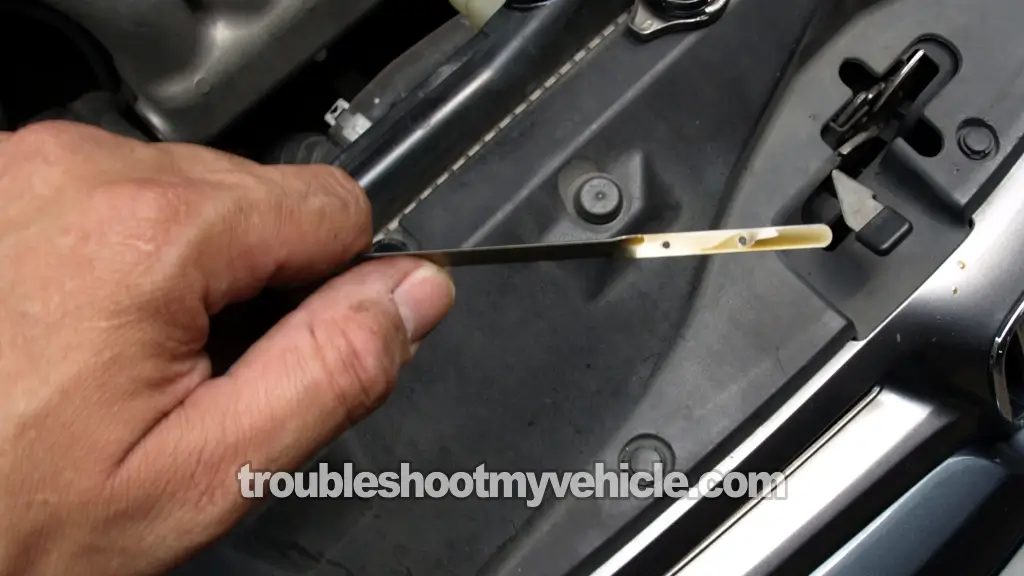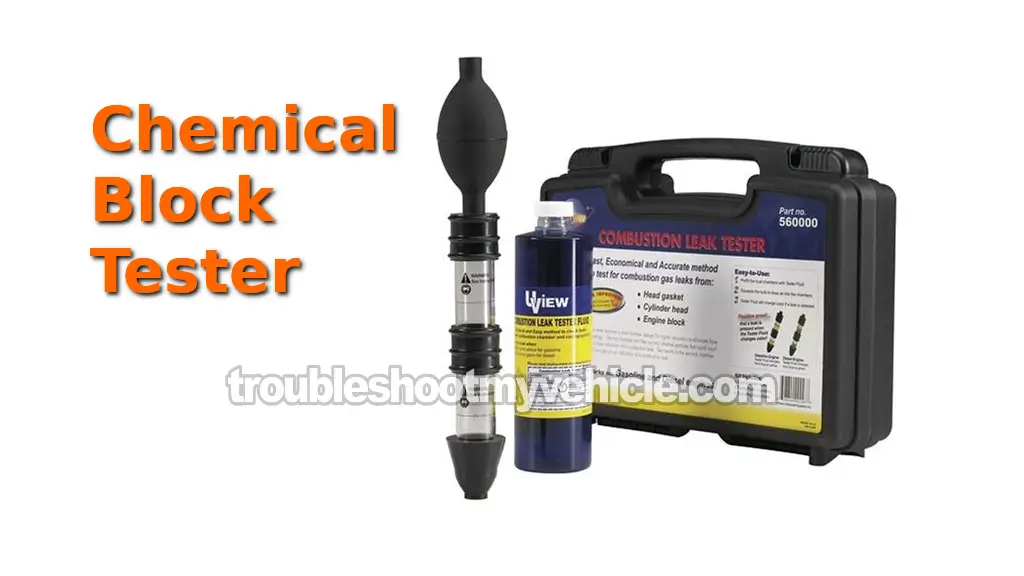
Finding out if your 2.4L Honda Accord has a blown head gasket can be done with four simple tests.
In this tutorial, I'll walk you through each one step-by-step so you can do them yourself and know for sure.
These tests aren't complicated, and I'll explain exactly what to look for in plain, no-nonsense terms.
Contents of this tutorial:
APPLIES TO: This tutorial applies to the following vehicles:
- 2.4L Honda Accord: 2003, 2004, 2005, 2006, 2007.
ENGINE NO-START DIAGNOSTICS:
Symptoms Of A Blown Head Gasket
A blown head gasket on your 2.4L Honda Accord will usually make its presence known in one or more of the following ways. Some symptoms are obvious, while others hide in plain sight until you start testing.
- Milky engine oil: You'll notice that the oil on the dipstick looks creamy and tan —like coffee with way too much creamer— when coolant leaks into the crankcase and mixes with the engine oil.
- Coolant shooting out of the radiator: With the radiator cap removed and the engine being cranked, you'll see coolant shooting up and out. This happens when compression and combustion pressure escape into the cooling system.
- Two side-by-side cylinders with 0 PSI compression: A burned head gasket between two neighboring cylinders lets compression escape from one into the other, leaving both with zero compression and an engine no-start problem.
- Overheating for "no obvious reason": Even after topping off the coolant and making sure the radiator fan works, the temperature gauge still climbs into the danger zone within minutes of starting the engine.
- Persistent misfire: Coolant leaking into one or more cylinders contaminates the air/fuel mixture, making the engine idle rough, hesitate, and lose power.
- Unexplained coolant loss: The coolant level keeps dropping, yet there's no external leak under the car or at the hoses —it's being consumed internally.
- Sweet smell from the exhaust: You'll notice a distinctive sweet odor and white smoke or steam coming out of the tailpipe when coolant is burning inside the cylinders from a blown head gasket.
In many cases, you won't see every symptom at the same time. That's why the four head gasket tests above are so important —they definitely cut through the guesswork and tell you exactly what's going on inside your engine.
TEST 1: Engine Oil The Color Of 'Coffee With Too Much Creamer'

One of the most common signs of a blown head gasket on a 2.4L Honda Accord is coolant leaking into the crankcase and mixing with the engine oil.
When that happens, every time you crank or run the engine, the coolant and oil churn together until the oil turns a light, milky color —kind of like coffee with way too much creamer.
Checking for this is quick and simple, and that's exactly what we'll do in this first test.
Here's how:
- 1
Pop the hood open and secure it.
- 2
Pull the dipstick out from the engine oil tube.
- 3
Take a good look at the oil on the dipstick:
1.) Does it look creamy-tan or off-white?
2.) Or does it still have its normal color and appearance?
Now, let's make sense of what you see:
CASE 1: The oil is creamy-tan, like coffee with too much creamer. This is a classic indicator of a blown head gasket.
Here's why it looks that way:
- The engine overheated enough to warp the aluminum cylinder head, which in turn damaged the head gasket.
- With the gasket no longer sealing properly, engine oil, coolant, and combustion gases can now mix freely.
- Coolant seeps into the oil pan, blends with the oil, and produces that light-tan, milky mixture you're seeing.
CASE 2: The oil looks normal. That's a good sign, but it doesn't completely rule out a head gasket problem.
If your Accord is still overheating or refusing to start, you'll want to keep testing. Head over to: TEST 2: Coolant Shooting Out From An Open Radiator.
TEST 2: Coolant Shooting Out From Open Radiator

Another very common sign of a blown head gasket on a 2.4L Honda Accord is when cylinder compression escapes into the cooling system instead of staying sealed inside the cylinder.
You can spot this by checking if the coolant blasts or bubbles out of the radiator (with the cap removed) while the engine is being cranked.
If you see coolant shooting upward during cranking, that's a strong confirmation the head gasket has failed.
IMPORTANT: If the engine has been running, let it cool for at least an hour before removing the radiator cap. Never remove the cap from a hot radiator or engine —serious burns can result.
If the engine isn't starting at all, you don't have to worry about it being hot.
- 1
Remove the radiator cap.
NOTE: Make sure there's coolant in the radiator. If it's low or empty, top it up with coolant or water until it reaches the neck of the radiator. - 2
Have a helper crank the engine while you stand a safe distance from the open radiator.
- 3
Watch what happens:
1.) Coolant shoots up or bubbles out of the open radiator.
2.) The coolant level stays completely still, with no bubbling or spurting.
Now, here's how to read your results:
CASE 1: Coolant bubbled or shot out of the radiator. This is a tell-tale sign of a blown head gasket, and no further testing is needed.
This happens when the head gasket has failed and/or the aluminum cylinder head has warped from overheating, allowing combustion pressure to enter the cooling system.
In a healthy engine, the coolant stays calm in the radiator during cranking —no bubbling, no surging, no drama.
CASE 2: The coolant didn't bubble or shoot out. That's the normal result, but if your Accord is still overheating or not starting, keep going with the next test.
If it starts, runs, but overheats, go to: TEST 4: Using A Chemical Block Tester (Combustion Leak Tester).
If it doesn't start or starts but runs with a misfire, go to: TEST 3: Engine Compression Test.
TEST 3: Engine Compression Test

If your Honda Accord overheated and now won't start, the next move is to check compression on all four cylinders.
Here's why: when a head gasket burns through between two neighboring cylinders, the compression from one leaks into the other. The end result? Both cylinders will read 0 PSI, and the engine won't start.
In this situation, you'll usually find two normal compression readings and two side-by-side cylinders reading 0 PSI. The affected pair could be #1 and #2, #2 and #3, or #3 and #4 —but they'll always be next to each other.
This type of failure can be tricky to spot since there's no coolant in the oil and no coolant shooting out of the radiator. A compression test is the sure way to confirm it.
NOTE: If you'd like a more detailed, stand-alone guide to performing this test, see: How To Test The Engine Compression (2003-2007 2.4L Honda Accord).
Here's how to do it:
- 1
Remove all four ignition coils.
- 2
Remove all four spark plugs.
- 3
Thread the compression tester into the first spark plug hole by hand.
NOTE: Hand-tightening is enough. Don't use tools —overtightening can damage the threads. - 4
Have a helper crank the engine while you watch the gauge. The needle will climb with each compression stroke until it stops rising.
- 5
Once the needle stops moving, have your helper stop cranking.
- 6
Write down the reading and the cylinder number (use the diagram above for reference).
- 7
Repeat the process on the remaining cylinders.
Here's how to make sense of your results:
CASE 1: All cylinders have normal compression. This means the head gasket is not burned between two cylinders.
If you still suspect a blown head gasket, move on to the next test: TEST 4: Using A Chemical Block Tester (Combustion Leak Tester).
CASE 2: Two adjacent cylinders have 0 PSI compression. This confirms the head gasket has failed between those two cylinders, and it'll need to be replaced.
TEST 4: Using A Chemical Block Tester (Combustion Leak Tester)

If the first three tests didn't confirm a blown head gasket, the chemical block tester is the go-to tool for finding the tough cases. When used correctly, it can tell you —with complete certainty— whether combustion gases are sneaking into the cooling system.
Why not start here? Simple: in about 95% of cases, TEST 1, TEST 2, and TEST 3 will give you the answer without spending a dime. This test is for the stubborn 5% that hide their symptoms well.
Here's the basic idea of how the block tester works:
- A special blue liquid is poured into the tester (see photo above).
- The tester is then fitted over the radiator's neck (you may need to lower the coolant level slightly so the tool can draw in air from the radiator).
- With the tester in place, start the engine and let it idle.
- Squeeze the rubber bulb to pull air from the radiator up through the fluid in the tester.
- If combustion gases are present, the blue liquid will turn yellow (for gasoline engines) —confirming a blown head gasket, a cracked cylinder head, or a cracked block.
- If the fluid stays blue, you can rule out a head gasket failure and those other issues.
You can pick up both the tester and the chemical at most auto parts stores, or you can order them online here:
Disclosure: As an Amazon Associate, I earn from qualifying purchases. Buying through these links helps support this site at no extra cost to you. Thanks for your support —it really means a lot!
More 2.4L Honda Accord Tutorials
You can find a complete list of tutorials for your 2.4L Honda Accord equipped car here:
Here's a small sample of the tutorials you'll find in the index:
- How To Test The TPS With A Multimeter (2003-2006 2.4L Honda Accord).
- How To Test The Fuel Injectors (2003-2007 2.4L Honda Accord).
- How To Test The Ignition Coils (2003-2006 2.4L Honda Accord).
- How To Test The MAP Sensor (2003-2007 2.4L Honda Accord).

If this info saved the day, buy me a beer!




